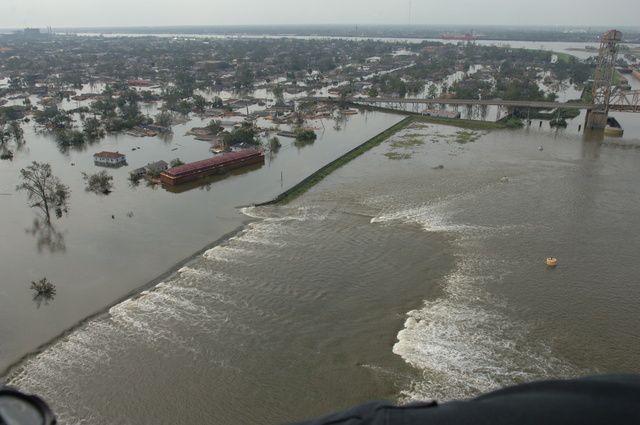Levee
|
In August 2005, Hurricane Katrina caused levees to break, releasing floodwaters into neighbourhoods in New Orleans, Louisiana. This aerial photograph shows the break in the levee in the 9th ward. Photo courtesy of Jocelyn Augustino/FEMA. |
The International Levee Handbook, published by CIRIA in 2013, defines levees as: "Raised, predominantly earth, structures (sometimes called flood defence embankments or dikes) whose primary objective is to provide protection against fluvial and coastal flood events along coasts, rivers and artificial waterways that are not reshaped under normal conditions by the action of waves and currents. Levees form part of flood defence systems that may also include flood walls, pumping stations, closure structures, natural features, etc."
As stated in the CIRIA definition (and outside of engineering applications), the terms levee and dyke are sometimes used interchangeably, but they are not technically the same.
Dykes are usually permanent structures that are built in areas that are located below sea level and are thus uninhabitable. Their placement reclaims land to make it fit for use. Levees can be permanent structures, such as those built from cement, or temporary structures which might be made from stone, earth or sandbags, and protect from flood.
There are also geographic/cultural preferences. For instance, in the state of Louisiana (which is vulnerable to flooding of rivers prompted by hurricanes), the term levee is most frequently used. In the lowlands of the Netherlands (which have been reclaimed from the sea), dyke is the common term.
See dyke.
In Ancient Egypt, levees were used along the Nile to protect the surrounding valleys and to irrigate the land. They were also used in other Ancient cultures such as Mesopotamia, where farmers built earthen levees to prevent rivers from flooding their fields.
[edit] Related articles on Designing Buildings
Featured articles and news
One of the most impressive Victorian architects. Book review.
RTPI leader to become new CIOB Chief Executive Officer
Dr Victoria Hills MRTPI, FICE to take over after Caroline Gumble’s departure.
Social and affordable housing, a long term plan for delivery
The “Delivering a Decade of Renewal for Social and Affordable Housing” strategy sets out future path.
A change to adoptive architecture
Effects of global weather warming on architectural detailing, material choice and human interaction.
The proposed publicly owned and backed subsidiary of Homes England, to facilitate new homes.
How big is the problem and what can we do to mitigate the effects?
Overheating guidance and tools for building designers
A number of cool guides to help with the heat.
The UK's Modern Industrial Strategy: A 10 year plan
Previous consultation criticism, current key elements and general support with some persisting reservations.
Building Safety Regulator reforms
New roles, new staff and a new fast track service pave the way for a single construction regulator.
Architectural Technologist CPDs and Communications
CIAT CPD… and how you can do it!
Cooling centres and cool spaces
Managing extreme heat in cities by directing the public to places for heat stress relief and water sources.
Winter gardens: A brief history and warm variations
Extending the season with glass in different forms and terms.
Restoring Great Yarmouth's Winter Gardens
Transforming one of the least sustainable constructions imaginable.
Construction Skills Mission Board launch sector drive
Newly formed government and industry collaboration set strategy for recruiting an additional 100,000 construction workers a year.
New Architects Code comes into effect in September 2025
ARB Architects Code of Conduct and Practice available with ongoing consultation regarding guidance.
Welsh Skills Body (Medr) launches ambitious plan
The new skills body brings together funding and regulation of tertiary education and research for the devolved nation.
Paul Gandy FCIOB announced as next CIOB President
Former Tilbury Douglas CEO takes helm.























